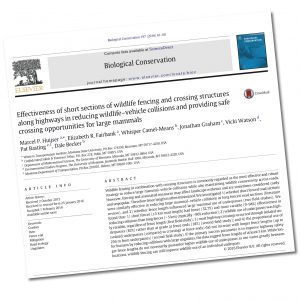Authors
Marcel P. Huijser, Elizabeth R. Fairbank, Whisper Camel-Means, Jonathan Graham, Vicki Watson, Pat Basting, Dale Becker
Publication
Biological Conservation

Abstract
Wildlife fencing in combination with crossing structures is commonly regarded as the most effective and robust strategy to reduce large mammal–vehicle collisions while also maintaining wildlife connectivity across roads. However, fencing and associated measures may affect landscape esthetics and are sometimes considered costly and unpopular. Therefore fence length is often minimized. We investigated 1) whether short fenced road sections were similarly effective in reducing large mammal–vehicle collisions as long fenced road sections (literature review), and 2) whether fence length influenced large mammal use of underpasses (two field studies). We found that: 1) short fences (≤ 5 km road length) had lower (52.7%) and more variable (0–94%) effectiveness in reducing collisions than long fences (> 5 km) (typically > 80% reduction); 2) wildlife use of underpasses was highly variable, regardless of fence length (first field study); 3) most highway crossings occurred through isolated underpasses (82%) rather than at grade at fence ends (18%) (second field study); and 4) the proportional use of isolated underpasses (compared to crossings at fence ends) did not increase with longer fence lengths (up to 256 m from underpasses) (second field study). If the primary success parameter is to improve highway safety for humans by reducing collisions with large ungulates, the data suggest fence lengths of at least 5 km. While longer fence lengths do not necessarily guarantee higher wildlife use of underpasses as use varies greatly between locations, wildlife fencing can still improve wildlife use of an individual underpass.
Links
http://www.montana.edu/research/publications/article.html?id=1937
http://www.sciencedirect.com/science/article/pii/S0006320716300350
